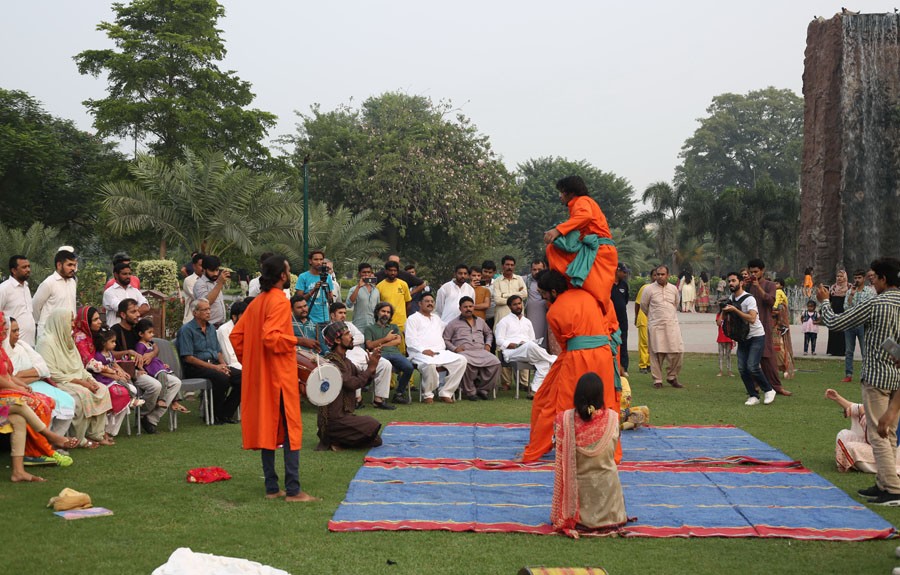
It is a good idea for theatre to not be restricted to one site, rather be mobile and free to roam the city

The Alhamra Mobile Theatre is a valuable addition to the cultural landscape of the city. Various groups, some well known, have strengthened the hands of Alhamra by agreeing to perform at public places such as the Race Course Park, Minto Park and busy spaces such as road crossings.
Media reports show that awareness-spreading performing arts have helped educate the masses on various social issues. This allows such an endeavour to be catagorised in the realm of theatre meant to reform and educate. It is didactic in intent.
It does happen, that theatre and other arts are treated as means of passing off an idea or value -- like civic responsibility, patriotism or religion -- that had matured elsewhere. In societies like Pakistan where a large number of people are illiterate, performance is seen as an adequate -- at times more than adequate -- means of achieving the same end.
In the heady days of Marxism, theatre or the arts were seen as a means of awakening the political consciousness in the face of oppression. The masses were educated on what ‘class consciousness’ was, what it meant to be the ‘proletariat’ etc. The hope was that such awareness would result in enough motivation and revolutionary political participation, to end the reign of oppression and exploitation.
Later many variations of political theatre evolved. Agit Prop, Living Theatre and Guerilla Theatre are a few of the many forms of street theatre present today, all meant to sensitise ordinary people to the high values of politics and its central role.
In older times, as indeed in some societies even now, the quest of theatre was to promote religious values. In Christianity, Hinduism and Buddhism, theatre or theatric rituals played an important part in promoting conformity.
In most theatrically developed cultures, the theatre is associated with its site or location. If a play is being staged in a particular theatre hall, the implication is that the theatre would be of a certain type or quality. The theatre outfits in the West, particularly in England, are totally determined by the company in-charge of the theatre. Whether it is the National or the Royal Shakespearean Company or the Bristol Old Vic it tells a lot about the type and quality of the play being staged.
But then touring theatres, both in the West and here, have a long tradition. In the late eighteenth and early nineteenth century, theatre developed along more commercial lines, it was basically situated in Bombay and Calcutta, where big theatre halls and a whole allied industry to support it were established. As these companies grew fabulously rich, the need was felt to also have touring units of these theatre companies to perform across the length and breadth of the subcontinent. Lahore did have many theatre companies but the most prominent ones were in Bombay and Calcutta, where people enthusiastically anticipated the staging of plays by these famous companies. So big and elaborate were the production units that at times an entire train had to be booked to accommodate the hundreds of hands to meet the production requirements for sets, props, orchestration and marketing.
In Lahore, many sites developed as favourite haunts of these big companies - Minto Park, where Minar-i-Pakistan is situated, and the area which is now Bansanwalla Bazaar next to Mayo Hospital. There was no Mayo Hospital and all the area adjoining Gowalmandi, outside the Walled City was the camping ground for these huge travelling theatre outfits.
The ‘talkie’ put an end to the roaring business of these theatre companies. The initial films in the silent era were also travelling outfits. But whereas the entire theatre company had to travel with hundreds of people and a huge paraphernalia of sets and costumes, the touring film was a much cheaper affair with only a projector, its operator and a few marketing hands. The projectors were hand operated and light was generated by a generator or battery. A screen was stretched across; it could be a chaddar or a board and people sat on the floor or charpoys to watch the film. A few musicians played the background score live, which was immensely popular across the length and breadth of the country.
But the essential point, sometimes missed, is that the message gets the better of theatre or art in itself. In many quarters this may seem to be irrelevant or just sophistry, for if the message is above reproach, then the question of it being done well; will linger in the shadows. It has to be done well to attract the attention of the unsuspecting audience. It is one thing to perform to converts and totally different to address the doubters or the rebellious. The play or film better be as appealing aesthetically as the message itself otherwise it peters out as any other half-baked act.
A dedicated and purpose-built facility is often more conducive to the effort than the makeshift. For one, it entails many distractions; and then the audience comes to visit the park and to eat and drink and not to see a play. It is a very different environment where people come willingly buying tickets. For a play to then succeed, the performance has to be twice as good.